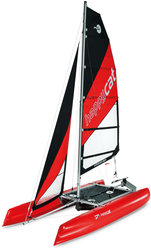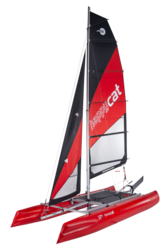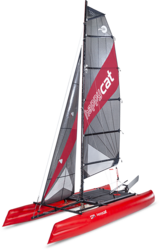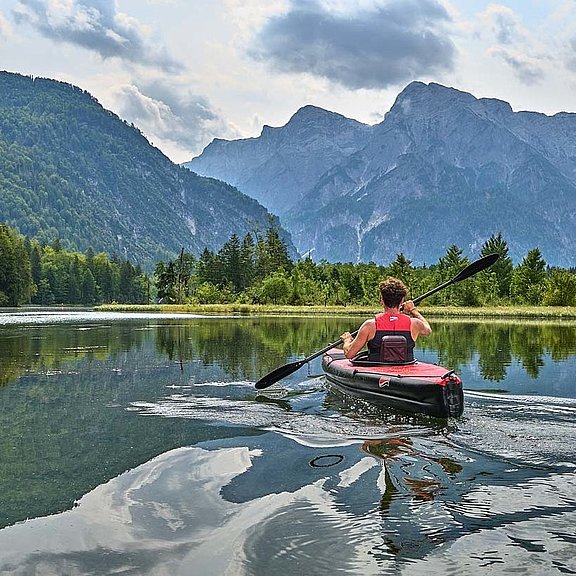
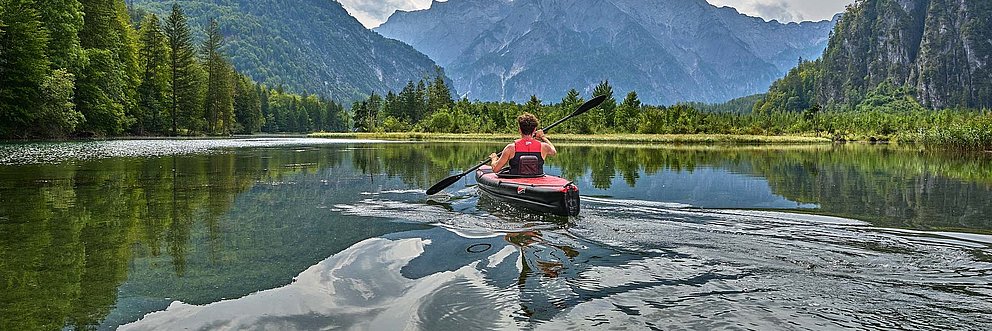

Frequently asked questions
Happy Cat
-
Does the HAPPY CAT fit into my car /rv/caravan?
The HAPPY CAT including mast is packed very small in 3 bags. These 2 long bags (185 x 30 x 30 cm) and 1 pack sack (80 x 45 x 28 cm) fit in most cars lengthwise, if you can fold down a rear seat. The front passenger seat and two rear seats remain free. If all seats in the car are needed, the HAPPY CAT can also be transported in a roof box. It is important that the internal height over a length of 185 cm, must be 30 cm high. Especially for RV and caravan owners, the HAPPY CAT is very popular due to its small pack size. The bags often fit into a back-end 'garage' or 'under the bed' into the vehicle. So no extra trailer for the catamaran must be carried.
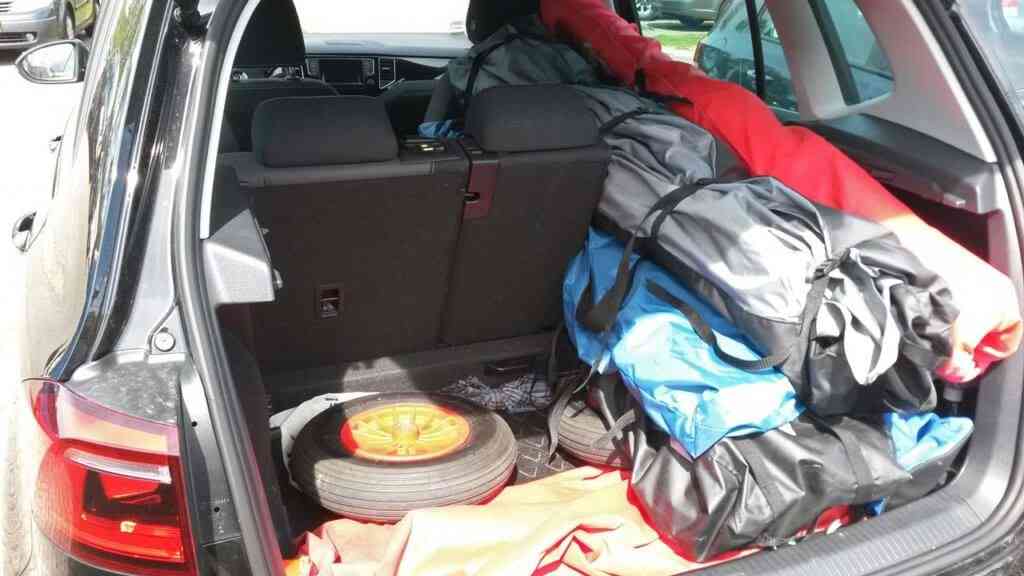
-
What should I bear in mind when storing the HAPPY CAT?
When the catamaran is stored assembled, several steps must be taken to ensure the longevity of the material.
The most important thing is to reduce the air pressure in the hulls to approx. 0.15 bar to prevent damage caused by overpressurisation.
The boat should be protected from heat in a shady place.The surface should be dry to protect the boat's skin.The catamaran should be protected from UV radiation. It is advisable to use a cover tarpaulin. The sails should be rolled up without creases and stored in the sail carrying bag under the tarpaulin. Fall lines should also be removed for longer periods of storage to protect them from UV radiation.
When using a carbon mast, it is advisable to remove it for longer storage periods and store it in the mast packing bag under the tarpaulin, protected from the sun. This will prevent the carbon from fading.
Observing these storage instructions will prevent damage, extend the life of the material and preserve its appearance.
-
How can i pump up the HAPPY CAT?
With the Grabner air pump (6 liters double stroke) pumping by hand for one EVOLUTION-hull takes on average 5 minutes.
If you want to have it completely comfortable, the electric air pump with battery can pump up one EVOLUTION-hull in about 4 minutes.
-
How long does it take to assemble or disassemble the HAPPY CATs?
All HAPPY CAT models are basically identical. Therefore, the assembly sequence and duration are very similar for each model.
Depending on routine skills, the assembly time varies. When you assemble the catamaran for the first time, the individual parts are still unknown and the sequence of assembly is not known from memory. You should therefore plan about 1 to 2 hours for the first setup. The assembly instructions and also a assembly video for each model, facilitate the construction essential!
If the construction is made step by step exactly as shown in the assembly videos, it takes together with the unpacking of the parts from the bags, with 2 persons and electric air pump:
NEO – 17 minutes
EVOLUTION – 19 minutes
HURRICANE – 21 minutes
If the setup is done by one person alone, the construction time will be extended by about 10 minutes per model.
Dismantling including packaging of the parts back into the bags takes about the same time.
-
How many people fit on the HAPPY CAT?
Due to the large-volume inflatable hulls, the HAPPY CATs can basically load a lot more than rigid catamarans of the same size. The maximum payload for each model is:
NEO – 3 adults + 1 child / 350 kg
EVOLUTION – 4 adults / 500 kg
HURRICANE – 4 adults / 600 kg
The best sailing performance is achieved, depending on how many people sail on the catamaran. We therefore recommend:
NEO – when mostly only 1 person sails
EVOLUTION – when mostly 2 people sail
HURRICANE – when mostly 2 people or more sailing or with a lot of equipment
Of course you can also sail with the maximum number of people allowed on the catamaran. The difference is, the catamaran will be a little deeper in the water and is not quite as fast.
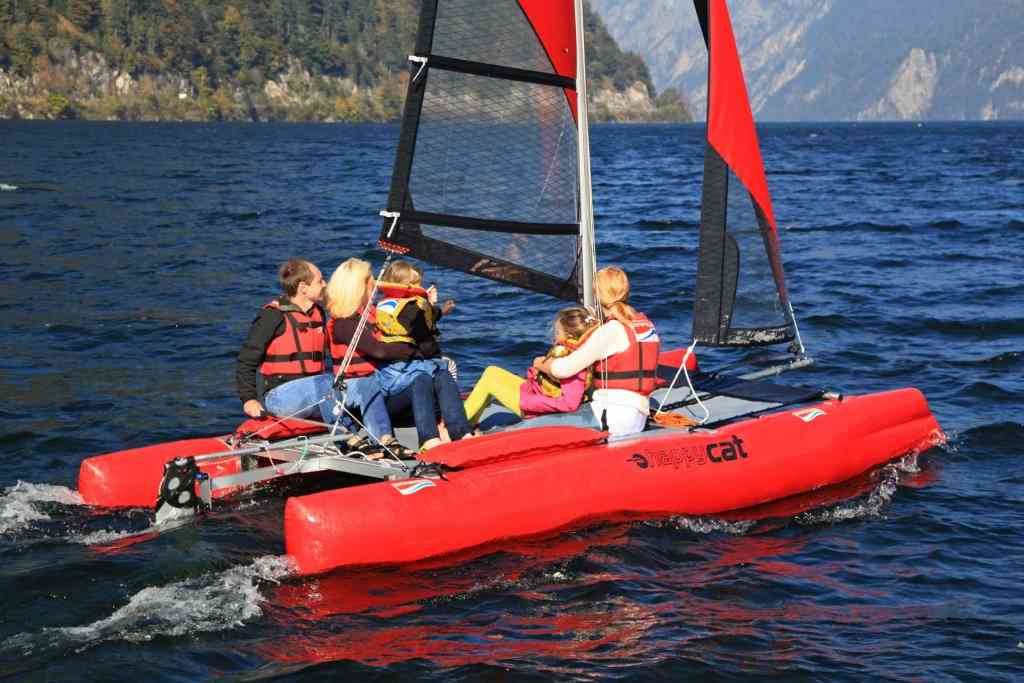
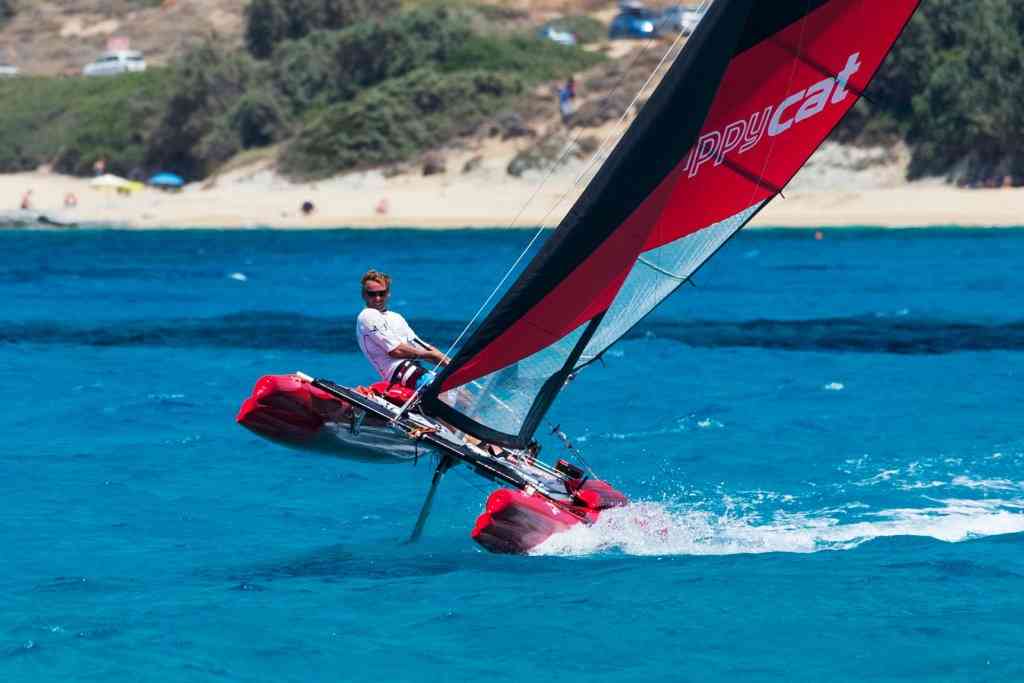
-
Why does the latest HAPPY CAT generation have convex ‘Wavepiercing’ hulls and no conventional hulls in ‘banana’ shape?
The company Semperit in Austria had produced catamarans since the 1960s. In the 1980s, Grabner took over and further developed this production. At that time, all hulls were still made as a simple ‘banana shape’.
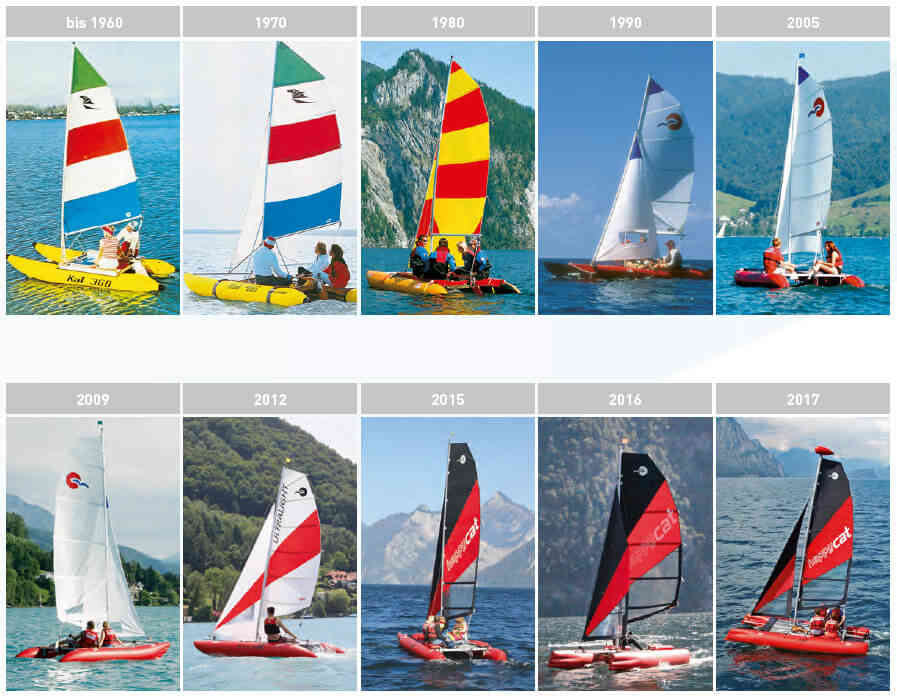
For the latest generation of HAPPY CAT models elaborate towing tank tests and field tests were carried out. It has been shown that the new hull shape with convex hull bottom (over the entire hull bottom front and rear slightly bent up) and wavepiercing bow, is the fastest hull shape with the least resistance.
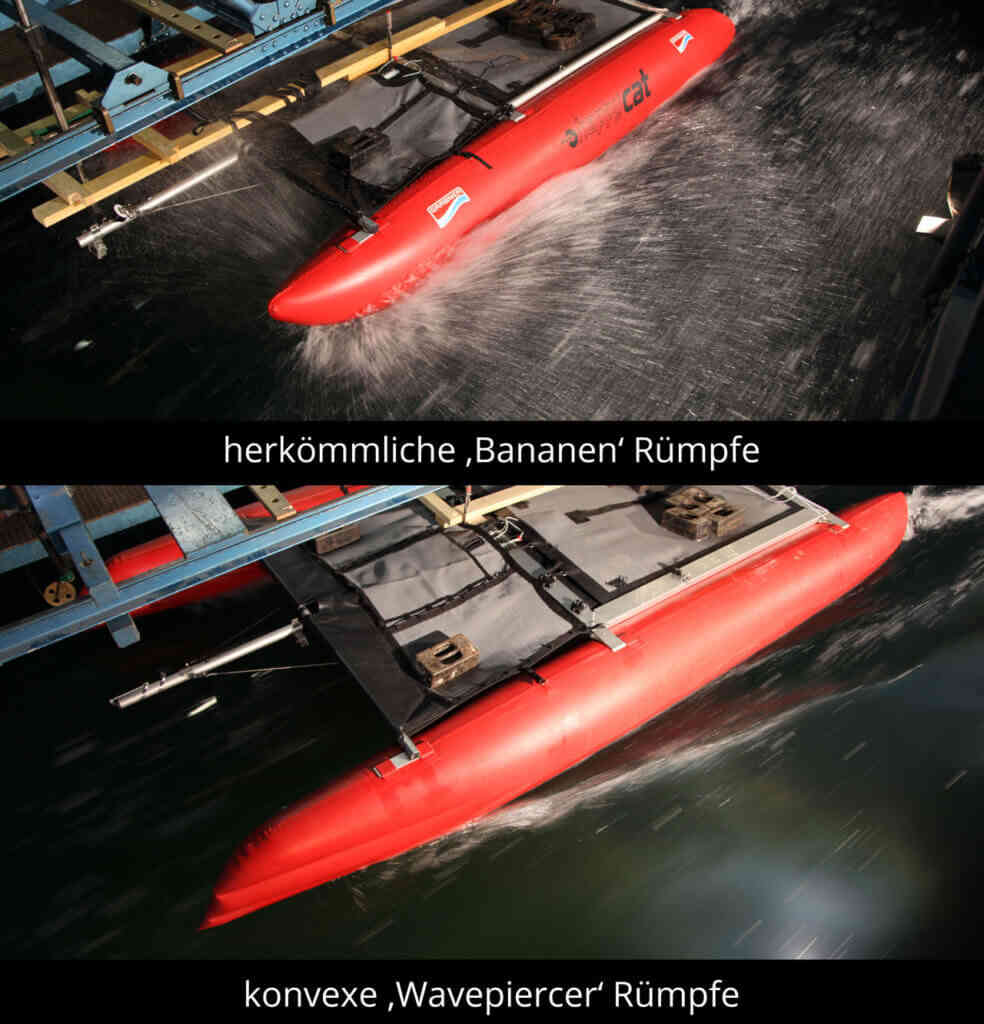
Comparison races with two identical HAPPY CATs, but one with new ‘wavepiercing’ hulls and one with old ‘banana’ hulls have shown, that the catamaran with the new hulls is 30% FASTER compared to the old conventional hulls.
The reason for this tremendous speed advantage:
The hull of the HAPPY CAT offers a maximum waterline in relation to the total length when used correctly. The bow has a well chosen buoyancy and a slim shape. This allows the bow tip to pierce through waves – depending on its size – causing less resistance than if the bow were bent “normally” and would clatter against any large-area – causing too much resistance and splashing water. On beam reach and downwind tracks, the lee hull does NOT dive, which is a huge advantage because it can be sailed safely on a hull.
In other words: The HAPPY CAT sails because of the modern hull shape much faster, quieter, safer and there is very little splashing.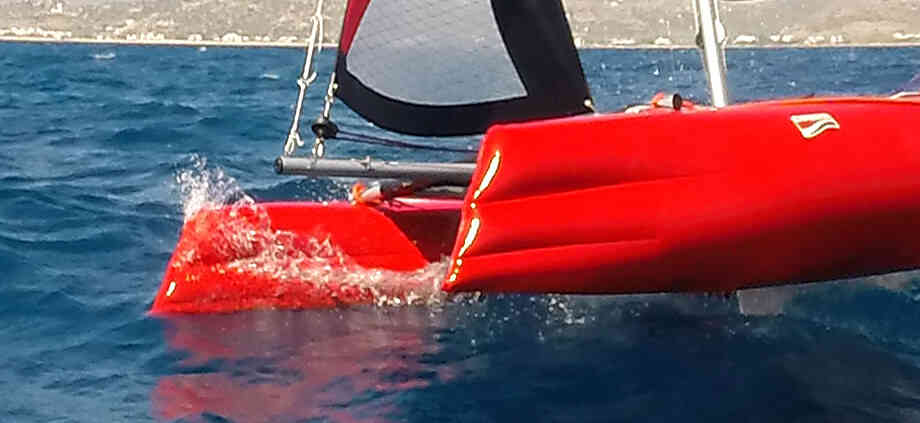
The towing tank measurements and field tests have shown, when the hull is in displacement drive the catamaran has the least resistance and is also the fastest, when the hull touches the water up to the tip of the bow nose. Any area of the bow that does not touch the water is unnecessary area. (Otherwise the hull could also be made shorter!)
If you want to make the best use of the hulls on CLOSE HAULED tracks, make sure to distribute the weight of people and luggage to the front, so that the hull touches the water as horizontally as possible – up to the tip of the nose – for the best performance. If you are sailing alone, you can sit directly behind the shrouds, when traveling with two people – of course depending on wind force, waves and body weight – one person can sit in front of the shrouds and the other behind. That’s because at close hauled tracks the catamaran is in a displacement drive and therefore a long waterline is better.
On DOWNWIND tracks, the HAPPY CAT can glide (eg if the gennaker is used), therefore it can be better if you place your weight a bit further backwards.
Opinions differ on the question of whether a catamaran is faster on one hull than on two. Our measurements have shown that when the windward hull is in the condition to just touch the water and is also already even slightly “lifted”, the highest speeds are possible.
-
What material are the hulls made of?
The hulls are made of EPDM/natural rubber like all Grabner inflatable boat skins, and not from PVC.
You get 7 years warranty on the boat skin. The long-term experience has shown that the lifetime of Grabner inflatable boats often is between 20 and 30 years. The boot skin is made of environmentally friendly ingredients and obtained by vulcanization firmest connections and a good abrasion resistance. Also, the UV resistance is very high, which is important if you want to use the boat in the sun. If anything happens, the EPDM boat skin can be easily repaired like a bicycle tube.
A Comparison to the UV exposure: If you spend the whole day in the sun, without using sunscreen, you get a sunburn. The same loads are also exposed to the boat skin. PVC boats usually only have a service life of 3 to 10 years on average and must then be disposed of as hazardous waste. A PVC boat skin contains many plasticisers to make the material flexible. These are hazardous to health and escape over time, making the material porous. If that’s the case, a repair is usually no longer possible. UV resistance is significantly lower for PVC than for EPDM. PVC joints are welded and often do not sustain high operating pressure. The “seams” then begin to loosen over time and fittings can detach.
More about this topic can be found here.
-
Why does the HAPPY CAT come with a long centre-board and not with short fins under the hulls?
In short:
• CENTRE-BOARD: When best sailing performance is desired, plus excellent close haul beating to windward properties, little leeway, precise trimming to suit every situation, highest speed and maximal robustness.
• FINNS: When sailing performance does not matter, so as less windward qualities, less track holding = plenty of leeway, not trimming possible, no longevity/robustness.Our predecessors the SEMPERIT company with their brilliant designer Eduard Heuzonter experimented already during the 1980s using fins at the hulls instead of boards. We too built prototype catamarans in 1987 and tested these with fins. At this present state today, to revert to building catamarans to have fins would be a retrograde step of development and bear fundamental disadvantages:
- Cumbersome and damage prone fixing to hulls
- The craft is continuously stored ashore resting on fins, with the entire weight pressing onto the fins. When sitting on the catamaran, or wishing to mount a tent on its frame, those fins be better dismounted, and when launching for a sail, to be re-attached. That is bothersome, damage prone and a cause for constant customer claim.
- Complicated launching of the catamaran and problematic landing. Landing on rocky shores or at high speed can quickly damage the fins.• The belief that fins be better when operating in shallow water is a misconception. The catamarans rudder still remains fully immersed in water, exactly as deep as a centre-board. To tilt the rudder, so that it does not reach so deep into the water, would create tremendous pressure and render the cat uncontrollable. Apart from that, a centre-board can be tilted so that it does not have such deep draft.
- MOST IMPORTANT
Using hull mounted fins with little draft does not allow for as good windward performance as that of a catamaran using a profile centre-board reaching deep into the water. Our trials DISTINCTLY arrived at that conclusion. It follow, that beating to windward a fin catamaran needs to tack far more frequent than a cat equipped with a deep centre-board. In offshore wind, this can even be dangerous!
- REASON FOR ENHANCED CLOSE-HAUL WINDWARD SAILING WITH A DEEP CENTRE-BOARD:
Compare the wings of a glider plane. They have a short depth, but extreme length (wingspan) The longer the wings the greater the lift, the more efficient the glider becomes. The board of a sail-boat behaves in the same manner. The deeper/longer the profile board is immersed in the water the greater and exerting the velocity of the water flow passing the profile. The faster the catamaran moves, the higher the efficiency of the board. In deeper water eddies generated by the hulls diminish, and the effect is greater. Figuratively speaking, the board gets a hold in the water the deeper it is immersed and the faster the craft moves. That allows it to sail closer to windward.
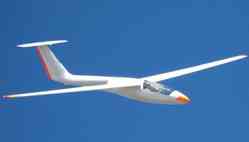
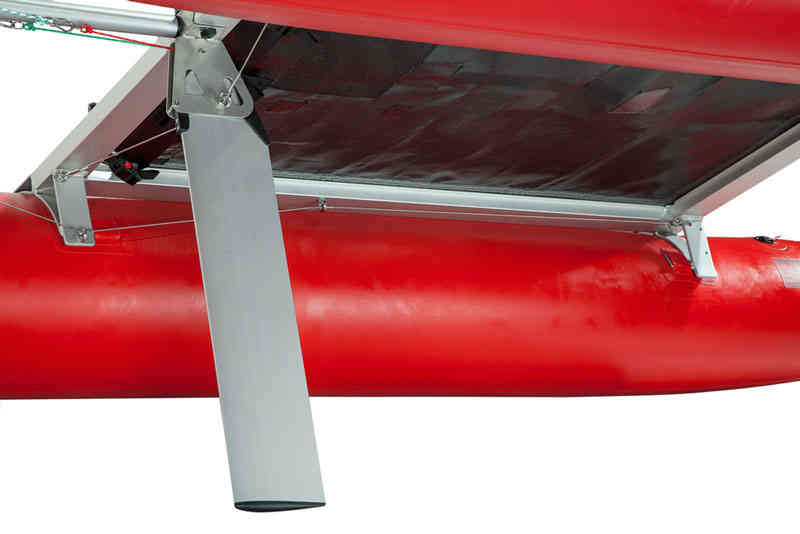
REASON FOR LESS LEEWAY WITH A CENTRE-BOARD:
A centre-board or fins are intended to prevent leeway. The deeper immersed in water the greater the effect. That is why a centre-board is more effective to prevent leeway. On the other hand, when the wind is blustery the centre-board may be set at a calculated angle intended to allow for a measure of drift. That cushions gusts and allows smoother ride characteristics and picking up speed.
REASON FOR PRECISE TRIM BY MEANS OF THE CENTREBOARD:
The centreboard is at any time the most effective means to adjust the centre of pressure to suit actual course and situation. When sailing to windward the centreboard may be set in vertical position to be most effective. That increases pressure on the rudder, felt on the tiller, and that is quite important for beating close-hauled. When broad reaching under moderate wind conditions the centre-board may be set at an angle of approximately 20°. That reduces rudder/helm pressure to the benefit of higher speed. When on the run before the wind, the centre-board may be lifted farther off the water to reduce resistance.EXPLANATION FINS:
Fins that reach into the water sparsely, have no flow profile and are of flat structure, THEY will generate no pressure, but eddies at the edges. That makes for little performance.
Added to that the swirls and eddies generated close to and by the hulls, which reduce the effectiveness of the fins further. The point at which leeway is to be prevented is located very high (not deep in the water) and is therefore of very little effect. - Cumbersome and damage prone fixing to hulls
-
What makes the HAPPY CAT sail closer to windward?
There are several reasons and facts, those most important are:
• a long and profile shaped centreboard that generates drive => “Why does the EVO come with a centreboard instead of fins?”
• Rigidity by way of square channel profile frame construct, plus high strength and an aerodynamic shaped profile mast, with swivel- joint mast foot technology. Those key design features ensure tight set foresail luff and mainsail properties, which are aerodynamic air-stream conform throughout. (further enhanced by an intelligent mainsheet-guide design).
• Custom-made foresail, controlled by optimised hauling point, thus allowing it to be set closer to the mast. That distinctly reduces the bear off angle in order to gather way.
• A sail-plan, foresail and main, custom-made and matched to complement the catamarans design features in detail.
• Mainsail, mainsheet-traveler => “What is the mainsheet- traveler for?”
• The Highspeed-Rudder”, facilitates optimised handling and trim of the catamaran.
-
HAPPY CAT NEO or HAPPY CAT EVOLUTION?
NEO
• When smallest pack dimensions and lowest weight is desired (e.g. small caravan).
• When only 1 to 2 adults or children sail.
• When sailing fun rates over ambitious challenging performance.EVOLUTION
• When highest performance and sailing under plenty of wind condition has priority rating.
• When full load (crew and luggage) is to be carried.
• When frequent sailing at sea, with respective swell is envisaged.
• When comprehensive equipment and sailing comfort is paramount.Differences HAPPY CAT NEO to EVOLUTION:
- About 20 kg less weight.
- 25% less pack dimensions.
- 9 m² sail area instead of 11.5 m².
- 3 HP motor performance instead of 6 HP.
- Max. 4 Bft. wind instead of 5 Bft.
- Marginally less accessory.
- Lower price
-
HAPPY CAT EVOLUTION or HAPPY CAT HURRICANE?
Decision criteria for the HURRICANE:
- When sailing mostly with 2 or more people
- When mostly sailing on large inland waters or on the sea at higher waves
- Even more storage space on the boat (for cruising with higher payload)
- Highest possible speed
- Small motor behind the rear deck is desired
- Little extra weight / additional price does not matter
Differences from HURRICANE to EVOLUTION:
- longer hulls = less resistance = faster
- 2 reinforcing bow braces = very stable hulls = faster
- larger hull diameter = more lift = more payload possible = higher hull stiffness
- Rear deck + engine mount possible (accessory) = more payload possible
- Mast foot ball joint = even better mainsail profile = more propulsion
- Mast rotation limiter = better trim option
- Rudder with snap-fix positions up / down = practical operation
-
Is it possible to use a motor on the HAPPY CAT?
Yes.
The following motor brackets are available:
For small motors up to 3 hp / 1100 watt / 18 kg. Recommendation: do not use at the same time when sailing, but either sailing or driving with motor.
MOTOR BRACKET LONG HAPPY CAT EVOLUTION / HURRICANE:
For small motors up to 3 hp or 1100 watts / 18 kg. Engine can stay mounted while sailing without disturbing. Ideal for calm wind!
MOTOR BRACKET HAPPY CAT HURRICANE STERN:
For small motors up to 3 hp or 1100 watts / 18 kg. Engine can remain mounted at the very rear of the HURRICANE during sailing without disturbing. Ideal for calm wind!
MOTOR BRACKET HAPPY CAT EVOLUTION / HURRICANE:
For motors up to 6 hp / 30 kg. For fast gliding up to 25 km/h. Recommendation: do not use at the same time when sailing, but either sailing or driving with motor.
In general long shaft motors (L) should always be used so that the engine is always running smoothly even when there are waves.
-
Why are the HAPPY CATs not lighter and cheaper than they are?
Of course, the weight of a boat is a deciding factor when use- and purchase considerations are made.
Be aware though, the lighter a boat the more filigree is its constructed!The weight of a boat incorporates every feature that makes up the series standard (that of course has its weight), and gives an indication in particular as to the boats stability and robustness of its design.
Because the components are SUBSTANTIALLY more solid, the sailing behavior and performance is much better. Beside that, all components are designed for a long lifespan:
• Hulls made of EPDM rubber – not PVC
• Strong Dacron sail cloth, well sewed – not thin fragile cloth, poor sewed
• Square channel profile frame connections – not round twisting pipes
• High strength-profile mast – not round weak bending pipe
• Stainless steel design centreboard retainer bracket
• Rudder – extremely rigid – not filigreeAND BECAUSE much more is contained in the standard equipment package:
• Longer tubes of top modern shape – designed for best sailing performance
• Solid foredeck cross bar
• Reinforced bowsprit
• High-speed rudder – for increased speed, directional stability, reduced effort of energy
• Pivoting mast foot joint – for easier assembly and dismantling
• Tiller-lock – for course and rudder fixation, e.g. when single handed paddling
• Mainsheet-traveler – for enhanced mainsail performance
• Infinite jib furling – easier foresail handling
• Double shrouds – ensures best mast and main sail shape and safety
• Rotatable mast technology – enhances mainsail profile
• 4-part pack-bag set included
• Paddle retainer
• Halyard pouch
• Serially drilled holes for:
– Gennaker brackets
– Slipping-wheels
– Motor bracketTherefore, it is understandable that the much more stable overall construction and the extensive basic equipment result in a low additional weight + low additional price. If one had to pay for what is available as standard (construction + equipment), the extra charge would be much higher.
MOST IMPORTANT OF ALL: Sailing is the finest and most beautiful leisure activity. For that reason the choice should be: a boat absolute top safe, offering the best of sailing properties, highest sailing comfort and enjoyment. The HAPPY CAT stands for best quality and it offers ultimate benefit.
-
For what reason is the mast profile of the HAPPY CAT so extremely rigid dimensioned?
The HAPPY CAT comes with a fairly large mainsail. To be able to use this large area as efficiently as possible requires a very strong mast. Static calculation and extensive research has led to a mast profile that allows most effective utilization of the mainsails maximal performance right to the top of the mast. The connection elements are not round but of square design for maximal strength and safety.
If the mast were not sufficiently rigid, it would be lighter, but would have three serious drawbacks:
- Due to the soft mast, the entire stability of the rig would suffer. As a result, the jib at the front (luff) would make a large bend “sickle” and thus the close hauled sailing characteristics would suffer considerably.
- A soft mast would bend strongly towards the lee at the top and thus the mainsail would also open in the upper area – twisting strongly into the wind – and much power would be lost. The large sail area would be for nothing.
- An insufficient stiff mast would present great danger when encountering conditions of strong wind. There would be not enough reserves and the mast could deform or even break.
-
Why does the mainsail of the HAPPY CAT have no boom?
- For reason of safety, so that a boom can not hit someone on the head and cause injury. That applies in particular, when family and children are on board. Safety is the most important thing!
- The diagonally-cut design of the mainsail provides valuable headroom for the crew, and more sail area near the mast. At the same time it reduces induced air resistance.
- Instead of a boom, the mainsails lowest batten is a bit stiffer. With a 5-eye clew board the sail-profile can be fine adjusted.
-
What is the mainsheet traveller for?
With the traveler the “twist” of the mainsail can be adjusted, so that the mainsail brings either more or less power. This significantly optimizes the sail trim and can be adapted to the current course and wind conditions.
Sailing downwind, by means of the mainsheet traveller the main can be hauled in tight towards luff for enhanced leech tension. That ensures good close hauled setting of the top part of the mainsail “Square-Head”, without allowing the wind pressure to open the lower parts (twist) of the mainsail.
On downwind you can set the traveller to lee and tighten main sheet. This will tension the leech of the mainsail and “close” the top “square head” of the main sail. This prevents a “twisted” main sail top.
Whether you want to sail sportive or relaxed, can be influenced with the Traveler. Under conditions of light winds the traveller may be set windward, allowing to sail closer to the wind (that raises helm pressure). For sportive sailing on one hull, the same setting may be applied, whereby the windward hull easier lifts off from the water.
If sailing under conditions of stronger wind, with particular intension to reduce the risk of capsize, the traveller setting towards lee (the side where the wind blows to) may be preferred, which reduces helm pressure and weather-helm (drag towards the windward side). The catamaran will sail safely and smoother in this configuration.
When sailing under conditions of plenty of wind close hauled, the centre of pressure can be moved farther backwards. The traveller shall be set close hauled, but the mainsheet can be opened a bit.
-
Why is the HAPPY CAT designed to have inbuilt weather-helm?
The tendency to bear into the wind depends on the setting of the centre board and mainsheet-traveller. Refer to “Why has the HAPPY CAT a long centreboard and not short fins?”
- Too little weather-helm, or even neutral to lee-helm tendency would have a negative effect on performance! On the one hand for reasons of security, if fallen off the catamaran, the catamaran must turn to windward and come to a halt. On the other hand for reasons of performance properties, because the catamaran would lose windward beating qualities. Our trials with neutral balanced settings resulted in remarkably less windward sailing qualities.
- On a sailboat the individual trim of the sails is very important. You have to feel how small changes affect sailing behavior. The rudder is designed so that such changes can be felt very good.
- A balanced rudder would not show up those effects to that extent, because one would feel no pressure at the tiller. One would sail with incorrect trim without noticing it.
- Too little weather-helm, or even neutral to lee-helm tendency would have a negative effect on performance! On the one hand for reasons of security, if fallen off the catamaran, the catamaran must turn to windward and come to a halt. On the other hand for reasons of performance properties, because the catamaran would lose windward beating qualities. Our trials with neutral balanced settings resulted in remarkably less windward sailing qualities.
-
Strong wind sails / reef / wind strengths
In short, our recommendation:
Up to 4 Beaufort wind is the recommendation to drive with standard sails. Starting at 5 Beaufort wind, the smaller ‘STRONG WIND SAIL SET’ is recommended, because in this wind stronger gusts can occur. This facilitates operation by reducing the tension of the sheets and protects the material.
The HAPPY CAT has been tested up to 6 Beaufort one-handed with the standard mainsail. The catamaran sails easily on one hull, so you should control the mainsheet in strong winds directly by your hand. During test drives, in some cases even 2 people sailed on one hull. It depends on the weight of the sailor, how high the catamaran comes out of the water.
The smaller ‘STRONG WIND SAIL SET’ therefore increases the tipping stability in stronger winds, reduces the load on the components and extends the service life of the individual parts.
Why is there no reefable mainsail?
In a reefed mainsail, there is a thick bulge in the lower area, this has poor aerodynamics, causes a bad sail profile, wrinkles and kinks in the sail and is generally disturbing, obstructs the view, etc.
On the water, it is very difficult to reef the sail in strong wind conditions with corresponding waves. Nor can you swap the big sail for a small one.
Therefore, the application of a smaller sail area is designed so that the appropriate sail area is selected even before going sailing. A tailor made smaller sail works better in this case than a reefed larger sail.
When the wind suddenly becomes too much
If you are already on the water and the wind is becoming too much, you can take away the mainsail completely and continue only with the jib. Numerous feedback from customers clearly confirmed that this works best.
(not) reduce jib sail size
The jib sail can be driven completely unrolled in full size. On prototypes there was also the possibility to use the foresail partially rolled up. In practice, however, it has been shown that this was never necessary, not even with a lot of wind. In the same way, the practical tests showed that it makes no sense to drive without jib sail.
In practice, in a nutshell:
If you notice during the assembly of your catamaran, that the wind is strong and possibly even children are on board, you can use the smaller ‘STRONG WIND SAIL SET’. The other way around, if there is little wind, the larger standard mainsail can be used. Generally we recommend, from 5 Beaufort to use the smaller sail set.
-
Does the HAPPY CAT capsize?
Yes, every boat can capsize.
When sailed properly the HAPPY CAT is very stable indeed. Any boat may capsize as a consequence derived from improper handling whilst under way, i.e. when the crew remains on the lee side instead of the windward side, or when sailing on one float with the other flying in the air is taken to extremes.
Capsize can easily be avoided, when the crews position is on the windward side, and during tacking the crew changes sides in good time, simultaneously slackening the sheets.
Does the HAPPY CAT upon capsize finish bottom-up?
Yes, the models with aluminum mast capsize bottom-up.
The models with carbon mast have a certain buoyancy and do not capsize immediately, but swim for some time about 45° diagonally in the water.
To avoid ending bottom-up there should a masthead float be fitted at the top of the mast. The masthead float is permanently inflated, keeps the mast floating on the water and righting after capsize is easier. It is fixed to the masthead and rotates along with the mast.
How can I righten the HAPPY CAT after a capsize?
The most important steps for righting the catamaran:
- Carry a minimum 5 meter righting-rope attached to the mast foot.
- Have knots fitted every 10 cm over the last 2 meters of the ropes end.
After capsize:
- Loosen and uncleat main sheet and jib sheet.
- Throw the loose end of the righting-rope over the skyward pointing float.
- Hold in the water the catamaran at the bow, so that the bow turns in the direction of the wind.
- Stand on the hull floating in the water and feed the righting rope once behind your body.
- Lean back as far as you can and hold on to the rope; the knots come in very handy for holding on and hauling in further.
- By deploying body weight into the rope, the catamaran will lift and eventually level when falling back onto the water.
- Immediately climb back onto the cat and continue sailing.
-
What advantages does the HAPPY CAT offer compared to solid hull boats?
The HAPPY CAT is an easy-to-transport catamaran that you can stow at home and is ready to sail in under half an hour, with comparable sailing characteristics of an identically sized rigid catamaran.
There are also highly sporty, big solid catamarans. These are many times more expensive to buy and also need a trailer and for this a garage or a mooring. So you see, we are talking about 2 completely different products.
To consider are also other benefits of HAPPY CAT:
- More payload / persons possible, due to greater buoyancy of the hulls.
- The inflatable wavepiercing hulls have a lot of buoyancy and therefore can handle waves better than solid catamaran hulls with low buoyancy (undercut/tip over forward).
- To operate as an electric or petrol motorboat
- Many accessories for versatile use (sun roof, bathing ladder etc.)
- Great bathing island for the whole family
-
Shrouds tension, lee shrouds, Dyneema – what makes sense?
For optimum propulsion, it is important that the mainsail has the best profile as possible over the entire height. This is achieved via the mast, the mast bend (set by shrouds lengths) and of course by the sail cut.
Shrouds length?
Here to find the best possible setting, which fits well with different wind strengths, can only be tested and adjusted by practical tests. In recent years, the company Grabner, together with experienced sailing experts, has carried out many complex tests and refined the detailed shrouds settings.
If you buy a new HAPPY CAT, it will already be delivered with the best possible set length of the short and long shrouds. If the basic setting of the shroud length is only changed by a few millimeters, the mast bending also changes significantly. This leads to a poorer mainsail profile and thus less propulsion. We therefore recommend that you do not change the shroud length and also do not install any shroud clamps, as this reduces the performance of the catamaran due to incorrect tensioning.
Lee shrouds not tight?
As weird as it sounds, but all the materials on the boat stretch – even the used stainless steel wire shrouds. In principle, we quite carefully take into consideration to use materials that have the lowest possible elongation. But unfortunately, a certain amount of stretching can not be completely avoided. So that the lee shrouds are not tight, already a few millimeters of elongation of the windward shrouds is sufficient. As accessory the ‘LEE-SHROUD TENSIONING SET’ is available, for the lee shrouds always to be tense without changing the basic setting of the shrouds lengths.
Shrouds made of stainless steel or Dyneema?
In order to be able to precisely adjust the shrouds lengths at the Grabner manufacture, stainless steel wires are used with professional stainless steel terminals (end pieces with eyes or forks). This has the great advantage that the shrouds can be precisely adjusted to the millimeter and the initial length of the wire no longer changes.
If the shrouds were made from a Dyneema rope, this would have some disadvantages:
- Basically, the initial length can not be set exactly to the millimeter, as with a stainless steel wire with terminals. (rope would have to be spliced)
- Dyneema ‘wanders’ during the first hours of sailing. It changes the initial length to a certain extent, which is then retained. This would make it even less possible to set the shrouds in the factory exactly.
- It would therefore be necessary to install shroud-trim-plates with which each sailor after a few hours of sailing would have to set the exact shrouds length.
- However, since some customers have no experience on different shrouds lengths and their effects on the sail profile or mast bending, an individual setting could make the rig trimmed negative.
Stretching of stainless steel and Dyneema
Although Dyneema is heavily advertised as if it had no stretch at all, our field trials have shown that it also stretches at high levels of strong winds. The used 4mm stainless steel wire has a similar elongation, like a comparable Dyneema rope, but with all mentioned differences. The HAPPY CAT also uses Dyneema ropes, but only for halyard lines and not for shrouds or important tension wires.
-
What is the cause of surface rust on stainless steel?
Within the process of fabrication from stainless steel (rudder/center board head fitting, motor bracket, …) s/s quality 1,4571 is used, whereas the standing rigging (shrouds, forestay, frame tensioning stay) are made from s/s quality 1,4401.
Except steel cables, when fabricated all metal parts, (subjected to laser cutting, welding, drilling,..) undergo a final process of acid cleaning. The purpose of that is to remove residual impurities such as welding scale, oxide layer, tarnish, extraneous rust, and metallic as well as organic contamination pressed in by mechanic processes.
Despite being of highest material quality standard, components and re-treatment, finest rust films may occur. This originates when metal particles contained in the air, or in water are carried and deposited on stainless steel parts. Those air- or water borne particulates usually settle in scratches, cavities and pits, not causing the s/s components to rust, but the particulates themselves
If that rust film is not removed frequently, the passive layer can not develop and will eventually cause the stainless steel to rust.
Solution:
Use a wire brush to remove the surface rust, and afterwards apply a s/s metal polish.
By process of “passivation”, in connection with oxygen the chrome content of the stainless steel develops a coating of oxide on the surface. That process can last for several days and re-occurs again and again, i.e. after damage of the surface. -
What are the performance characteristics of an inflatable boat in comparison to a solid hull boat?
That depends entirely on the demands of the sailor.
In professional sailing, sails are usually used for 1 to a maximum of 3 years.
In recreational sailing, a maximum service life of approx. 7 years is common.
At the HAPPY CAT sailing meeting, Semperit catamarans more than 40 years old took part, which still had the original sails, although they were already very shapeless, soft and faded.
Why does the duration of use fluctuate?
Dimensional stability
The red/black HAPPY CAT sails are made of so-called "Dacron" sailcloth. This is a polyester fabric whose fibres are made dimensionally stable with resin. This dimensional stability is very important for a good sail profile. If the sailcloth is bent, the resin "breaks" and the fibres become soft, so that the sail as a whole becomes soft and loses its dimensional stability.
To ensure that the sails of the HAPPY CAT last as long as possible, a relatively thick/heavy 6 oz sailcloth from the brand manufacturer Challenge Sailcloth is used as standard. In addition, each HAPPY CAT comes with its own protective bag as standard, for gentle and UV-protected packing of the sails.
The windows of the HAPPY CAT sails are made of X-Ply. This is a very dimensionally stable laminate that is reinforced with fibres. Here, too, the same handling applies as with Dacron. If the material is bent or the sail is left to "beat" unnecessarily in the wind with open sheets, it becomes soft and loses its dimensional stability. Therefore, for both Dacron and X-Ply, if the sail becomes soft or damaged due to kinking, this is not covered under warranty. The sails must always be rolled carefully and must not be bent or folded. (see point 'Careful storage').
Colour/UV stability
Most sails are predominantly made of white Dacron. White sailcloth has the advantage that the colour does not fade noticeably due to aggressive solar UV radiation. The HAPPY CAT was also made with classic white Dacron sails until 2014. At that time, customers often requested a more modern and sleeker design.
Since 2015, the sails have therefore been manufactured with a red/black/transparent design. Intense sun UV radiation can fade the colour over the years and make the material brittle. This is technically unavoidable. Here, it is a common value in the sailing industry that a change in colour becomes noticeable after approx. 2 years of average use.
This colour change also indicates a reduction in overall stability. A heavily faded sail has on average 50% less stability than it had when new. Any repair of such a sail therefore makes no sense. It is at the discretion of each sailor to continue using the sail or to replace it.
Most gentle storage
Especially in the leisure sector, it is often expected that the sails have a very long service life. In other words, a long shape stability and long optically appealing. This is in contradiction to the state of technical feasibility.
So if the sailor wants to have sails that retain their shape and look beautiful for as long as possible, we recommend careful handling and, when not in use, storage away from the sun.
The sails should always be packed dry. In the case of the headsail, care should be taken that it is not removed from the catamaran in the rolled-up state and then the rolled-up sail folded twice. When packing, the open/flat headsail should therefore be placed on top of the mainsail and rolled up without folds in a roll.
With the sail bag included as standard, the sails can be packed away protected from the sun. When the catamaran is not being sailed, the sail should be removed and stored in the bag.
Ongoing sail cutting improvements
The HAPPY CAT sails have been further improved and refined every year in the course of the last few years. Current sails are profiled noticeably differently and details are executed differently than when the new design was introduced in 2015. The size of the sails themselves has remained identical. It is therefore possible at any time to retrofit a new optimised headsail or mainsail for an older year of construction.
Fazit
If the sailor always wants to have sails with the best possible sail profile and the most beautiful colour, he cannot avoid renewing the sails after approx. 2 to 3 years. This is simply not technically feasible in any other way.
If the sailor can live with a change in shape stability and colour, the sails can also be used for longer if they are handled carefully.












